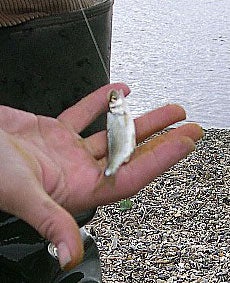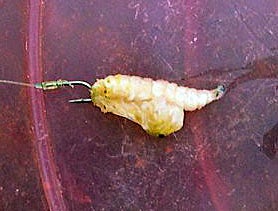| MARK WINTLE |
| Mark Wintle, an angler for thirty-five years, is on a quest to discover and bring to you the magic of fishing. Previously heavily involved with match fishing he now fishes for the sheer fun of it. With an open and enquiring mind, each week Mark will bring to you articles on fishing different rivers, different methods and what makes rivers, and occasionally stillwaters, tick. Add to this a mixed bag of articles on catching big fish, tackle design, angling politics and a few surprises. Are you stuck in a rut fishing the same swim every week? Do you dare to try something different and see a whole new world of angling open up? Yes? Then read Mark Wintle’s regular weekly column. |
Crazy Dace Last year, I visited Christchurch Harbour for the first time, targeting the shoals of mullet. Fishing bread punch, I also had plenty of good-sized dace and roach as well as a bream and mullet. A year later, with a fridge full of maggots left over from the Thames fish-in, I decided to have another go, but this time concentrating on the dace. What followed was one of the most frustrating and frantic day’s fishing that I’ve had for a long time.
Armed with three pints of white maggots and float tackle, I made the long walk across Stanpit Marsh and set-up in the same swim as previously. I’d already checked the tide tables; low tide was about eleven, giving me two and a half hours of runoff before the rising tide would hopefully run back the other way and sustain the flow. Early July was cool, and the blustery downstream North-Westerly breeze was going to make things tricky, at least until the tide turned. To make life easier, I set up a bait stand out as far as I could wade. This allowed me to fish a stick float at close range and feed by hand. The Set-up Because I already had some idea of the depth, I used trial and error to get the right depth. Over time, the depth varied anyway due to the tide so I had to make adjustments during the day. I started by setting the float to about five feet. When it started to drag, I simply push the float down an inch or two (who needs metric? It wouldn’t make sense to say 25 or 50mm!). Loads of bait
After an hour and a half, though the tide had been due to change it continued to drop. The dace continued to feed but I noticed that amongst the reasonable sized ones I was getting more and more tiddler dace. These were only around four inches long and meant that I had to change the bait every cast. Their small size also meant more missed bites. I tried stepping up the feed but to no avail. It was a case of catching what I could and hoping that eventually the better dace would fight their way through to get a better share of the loose feed. Then the tide turned I had noticed that many of the smaller dace were grabbing the bait almost off the surface, and with this in mind I changed the shotting set-up so that majority of shot were bulked around twenty inches from the hook with two no. 8 droppers on the hooklength. Over the next hour I set about catching the dace with a vengeance yet the problems with the maggot-chewing tiddlers persisted. Oddly, I had not even seen a single roach. Further towards the sea the harbour widened out. At some point, the water must become too salty for the coarse fish, and having caught well over a hundred dace, I reckoned that a move a few hundred yards seaward would do no harm just to see if I could still pick up coarse fish.
Bigger fish in the new swim Photo call
These had been interesting sessions after the dace. I probably didn’t experiment enough the first time around; perhaps I need to set up two rods and take more of a matchman’s approach to determining the best method. I certainly timed my visits well for the extra colour had brought the dace on the feed. When the colour dropped out a week later so the dace fishing got a lot more patchy. But as ever I’ll return to the harbour another day. Next week: ‘Floatfishing Up In The Water’ |

















